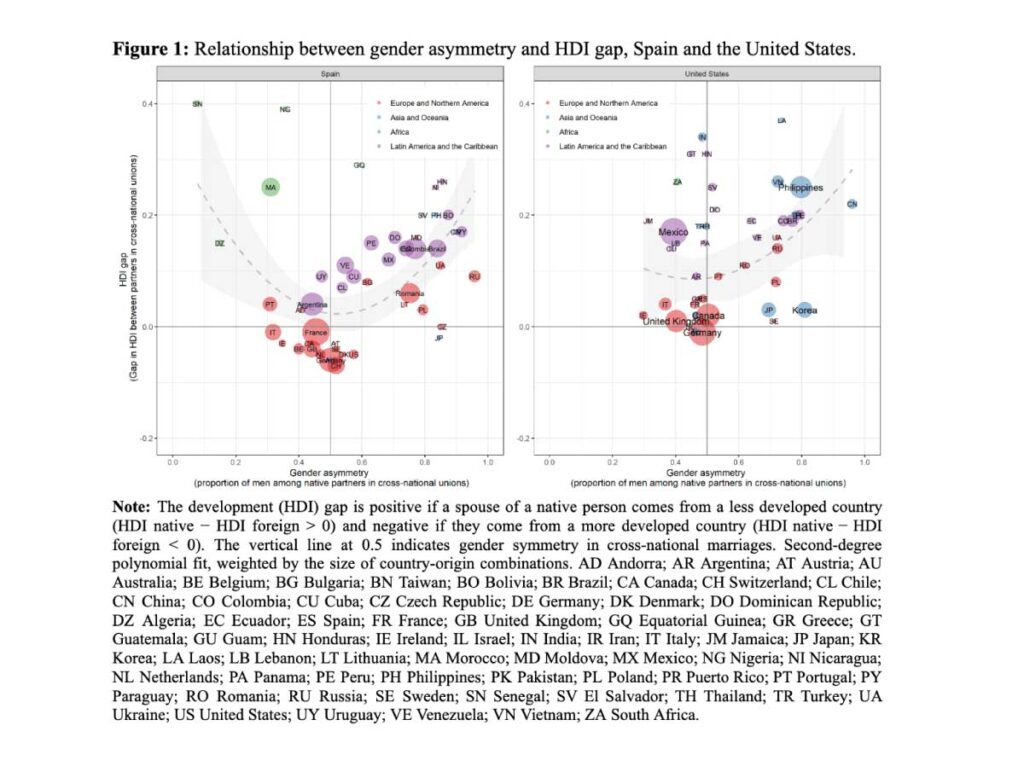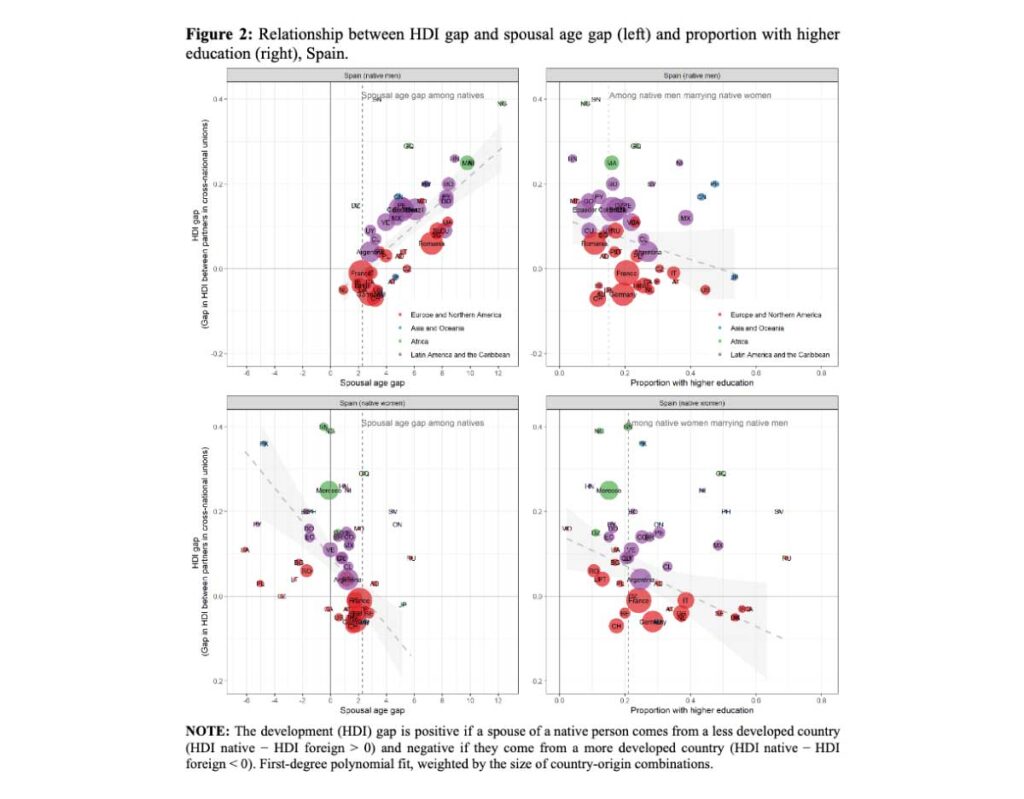An increasing number of people in high-income countries marry or cohabit with partners who were born abroad. Using census microdata for Spain and the United States, Albert Esteve, Annika Elwert and Ewa Batyra examine gender differences in cross-national heterosexual couples regarding country of birth, age, and educational attainment, and find well-differentiated patterns by gender in marital interaction with the foreign population.
According to data from the 2010 round of population censuses in Spain and the United States, roughly 10 percent of young couples (aged 30–39) involve a native and a foreign-born partner. However, the macro-level characteristics of these couples have rarely been researched and to date, most studies on cross-national couples in high-income Western countries have focused on the migrant’s perspective (Qian, Glick, and Batson 2012, Kulu and Hannemann 2018). In a recently published paper, we shift attention to the natives (Esteve, Elwert and Batyra 2023). We examine differences in union patterns of native women and men in cross-national unions. In a context of profound transformation of gender norms and roles in high-income countries, we aim to stimulate research on the gender dynamics that shape interactions of native populations with foreign-born individuals in an increasingly global world (van de Putte et al. 2009, Esteve, Garcia-Roman and Permanyer 2012).
Gender differences in country of birth, age, and education
We use samples from the International Integrated Public Use Microdata Series and focus on cross-national couples formed by women and men aged 30-39. We compute the age gap between spouses and dichotomize education according to whether each partner has tertiary education or not.
Finally, we analyze gender asymmetry in cross-national couples as follows: for each country of birth of the international partner, if there are at least 50 unions of this type (otherwise we drop all observations), we calculate the share of those where the native is the man. A share of 0.5 indicates that native men and native women are equally likely to partner with immigrants from a given country. To systematize the gender patterns that might exist in relation to these unions, we classify countries based on their level in the human development index (HDI). For each dyad, we compute the HDI gap between the native country (i.e., the United States or Spain) and the country of birth of the international partner.
Figure 1 shows the relationship between gender asymmetry in cross-national couples and the HDI gap, separately for Spain and the United States. Although the origins of international partners differ across the two countries, the results for the two nations suggest a similar pattern. Cross-national couples have very distinct gender profiles, with native men and native women partnering with immigrants from countries at very different levels of development. In both countries, gender asymmetry in cross-national couples increases with the HDI gap.

This means that unions between a native and a foreigner from a less developed country (HDI gap above zero) are formed predominantly by native men, as opposed to native women. For example, see the case of the Philippines: in both Spain and the United States, more than 80 percent of mixed unions with individuals from the Philippines involve a native man and less than 20 percent a native woman. Conversely, women tend to be overrepresented in unions where a spouse is from a country with a similar or a higher level of development (HDI gap around or below zero). This pattern is clearly visible for unions of natives with immigrants from Western Europe such as Belgium, Germany, or the United Kingdom. For example, 60 percent of unions with Belgians in Spain involve Spanish women and only 40% involve Spanish men.
With reference to Spain, Figure 2 provides further evidence about gender asymmetries in cross-national unions according to age and education. Native men in cross-national unions (top panels) tend to partner with younger women (spousal age gaps > 0) and the difference tends to increase sharply with HDI gap. This pattern reverses in the case of native women (bottom panels), for whom the spousal age gap tends to decrease and become negative with an increasing HDI gap (Figure 2, left panels). Similar patterns are found for the United States (not shown here).

Despite stark asymmetries in age between spouses in cross-national couples and between unions of native women and native men, the right panels of Figure 2 show that educational profiles are rather similar across genders. There is no clear link between educational attainment of natives in cross-national unions and HDI, although in many dyads, natives tend to be have an above-average educational level. This pattern is even more visible in the United States (not shown here).
Conclusion
We find distinct cross-national marriage patterns between native men and native women. Native men who partner with immigrant women from less developed backgrounds form unions with rather traditional patterns of spousal age differences, especially when the HDI gap is large.
At the same time, some native women might be challenging this pattern by forming unions with younger men from countries with a lower development level.
References
Esteve A., A. Elwert, E. Batyra. 2023. Gender Asymmetries in Cross-National Couples. Population and Development Review.
Esteve A., J. Garcia-Roman, I. Permanyer. 2012. The Gender-Gap Reversal in Education and Its Effect on Union Formation: The End of Hypergamy? Population and Development Review 38(3): 535–546.
Kulu H., T. Hannemann. 2018. Mixed Marriage among Immigrants and Their Descendants in the United Kingdom: Analysis of Longitudinal Data with Missing Information. Population Studies 73(2), 1–18.
Qian Z., J.E. Glick, C.D. Batson. 2012. Crossing Boundaries: Nativity, Ethnicity, andMate Selection. Demography 49(2): 651–675.
Van de Putte B., F. van Poppel, S. Vanassche, M. Sanchez, S. Jidkova, M. Eeckhaut, M. Oris, K. Matthijs. 2009. The Rise of Age Homogamy in 19th Century Western Europe. Journal of Marriage and Family 71(5): 1234–1253.


